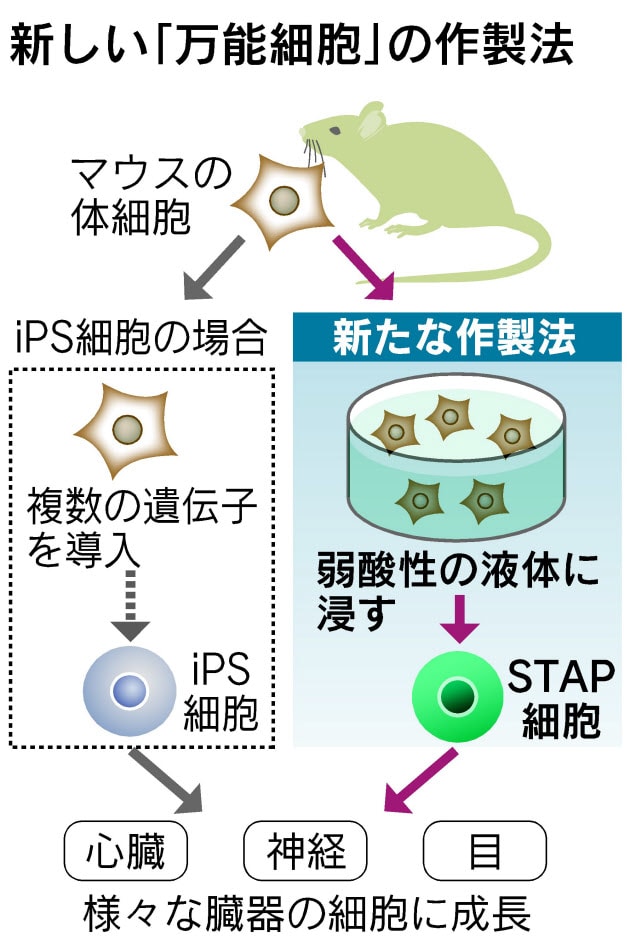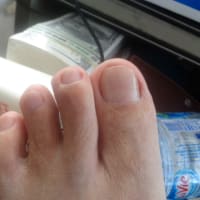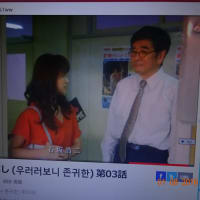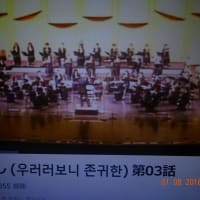その1のタイトルにしてブログです。
というのも日本時間では間もなく日が変わるから
我がブログは明日の日付が入るからです。
なんと若い日本人女性研究者がノーベル賞級の大発見を!!
明日掲載予定のNatureのまえに国内外の各マスコミが発表
科学者の端くれとしてこんなに簡単に体細胞が万能細胞に変化することに思いを馳せました。
実は現代科学では匙を投げたたとえば悪性腫瘍の患者が
転地療養や民間薬や代替医療で信じられない回復を!!
でもその割合は1万人に1人0.01%
これでは厚労省もWHOも医療として
認めるわけにはいかない。
でも吾輩は転地療養ではないがサイゴンンという熱帯地方に来て
日々の感動生活以外に心身の健康度が著しく変化
上昇しているって感じている。
これって環境刺激が不穏な細胞を除去し万能細胞が発生して
悪いものと交換しているって感じる。
科学者の端くれの端くれらしい
発想ですが!!
てなことで
彼女の紹介!!
新進気鋭の30歳、美人はどうでもいいが若い女性です。

研究者なら誰でも憧れる大発見
でも恵まれるのは何百万人に一人!!!
まあ研究者は純粋で恵まれるって表現は悪いです。
とにかく自分が驚く世界が驚く発見をしたい間違いなく研修者の夢
ひょとして彼女はその夢を達成、
今後は名誉もポジションも!!!

先ずはNikkeiの記事から!!


理研、万能細胞を短期で作製 iPS細胞より簡単に 2014/1/29 21:00
理化学研究所などは様々な臓器や組織の細胞に成長する新たな「万能細胞」を作製することにマウスで成功したと発表し、30日付の英科学誌ネイチャーに掲載される。iPS細胞よりも簡単な方法で、短期間で効率よく作製できるという。人間の細胞でも成功すれば、病気や事故で失った機能を取り戻す再生医療への応用が期待される。
STAP細胞の発見を発表した小保方晴子理研ユニットリーダー(神戸市中央区)
成功したのは理研の小保方(おぼかた)晴子ユニットリーダーらで、米ハーバード大学や山梨大学との成果。
iPS細胞は複数種類の遺伝子を組み込んで作る。小保方リーダーらは、マウスの細胞を弱い酸性の溶液に入れて刺激を与えることにより、様々な組織や臓器の 細胞に育つ能力を引き出した。「刺激惹起(じゃっき)性多能性獲得」の英語の頭文字からSTAP(スタップ)細胞と名づけた。
生後1週間 のマウスから取り出した血液細胞の一種、リンパ球を採取し、弱い酸性の液体につけた。リンパ球がSTAP細胞になる確率は7~9%で、iPS細胞の1%未 満より効率よく作製できる。作製に要する期間も2~7日で、iPS細胞の2~3週間よりも短い。リンパ球以外では、皮膚や肺、心臓の筋肉などの細胞からも 作れた。
STAP細胞を培養したり、マウスの体内に移植したりすると、神経や筋肉、腸など様々な細胞に変化することを確認した。iPS細胞では作れなかった胎盤に変化することも確認した。研究グループはSTAP細胞が様々な細胞に変化することを証明できたと説明している。
人間に応用できるかどうかはまだ不明。iPS細胞では、人間の皮膚や血液の細胞から様々な臓器や組織の細胞ができることが確認されている。研究グループは他の動物や人間の細胞から作る研究も始めた。
RTE News Wednesday 29 January 2014 14.05
Revolutionary stem cell approach could be 'game-changer'
Cells can be reprogrammed into an embryonic-like state by altering their environment
A "revolutionary" new approach to creating stem cells in the laboratory could open up a new era of personalised medicine, it is claimed.
Scientists have shown it is possible to reprogramme cells into an embryonic-like state simply by altering their environment.
It means in principle that cells can have their developmental clock turned back without directly interfering with their genes - something never achieved before.
The cells become "pluripotent", having the potential ability to transform themselves into virtually any kind of tissue in the body, from brain to bone.
Reprogramming a patient's own cells in this way is seen as the Holy Grail of regenerative medicine.
It raises the prospect of repairing diseased and damaged organs with new healthy tissue that will not be rejected by the immune system.
Current methods of performing the same trick involve genetic manipulation, which carries with it a serious risk of triggering cancer.
But the new method described in the journal Nature requires no genetic tweaking.
Scientists simply bathed immature white blood cells from mice in an acidic solution for 25 minutes.
Tests showed that, stressed in this way, some of the cells lost their "blood identity" and produced gene markers typical of early embryos.
When these cells were transferred to a special growth-promoting culture medium they began to multiply and acquired features typical of embryonic stem cells.
After being injected into embryos, they contributed to the body tissue of baby mice.
The scientists, led by Dr Haruko Obokata, from the RIKEN Centre for Developmental Biology in Kobe, Japan, named their creations "STAP" (stimulus-triggered acquisition of pluripotency) cells.
Commenting on the research, Dr Dusko Ilic, a reader in stem cell science at King's College London, said: "The approach is indeed revolutionary. It will make fundamental change in a way how scientists perceive the interplay of environment and genome."
Colleague Professor Chris Mason, Chair of Regenerative Medicine Bioprocessing, at University College London, said: "If it works in man, this could be the game changer that ultimately makes a wide range of cell therapies available using the patient's own cells as starting material - the age of personalised medicine would have finally arrived."
He added: "Who would have thought that to reprogramme adult cells to an embryonic stem cell-like (pluripotent) state just required a small amount of acid for less than half an hour - an incredible discovery."
Team found inspiration in nature
The Japanese and US team was inspired by examples from nature where the physical environment appears to alter cell identity.
Temperature helps determine the sex of crocodile embryos, for instance, while frog cells fated to form skin develop into brain tissue if exposed to acidic, low pH conditions.
In plants, environmental stress can reprogramme mature cells into "blank slate" cells capable of forming whole new structures including roots and stalks.
Although pluripotent embryonic stem (ES) cells can be "mined" from discarded early-stage human embryos, this practice is controversial.
Much attention has focused on an alternative solution, creating so-called induced pluripotent stem (iPS) cells by reprogramming the genes of adult cells.
However, iPS cells, made by injecting a cell with foreign genes, have a known tendency to trigger uncontrolled tumour growth.
STAP cells could potentially lift this barrier to using stem cells in medicine, though scientists are still a long way from conducting such experiments.
So far STAP cells have only been made from immature mouse cells.
Writing in Nature, Professor Austin Smith, from the Cambridge Stem Cell Institute, said: "It remains to be seen whether adult cells will respond similarly."
Prof Mason stressed that STAP cells will not immediately replace iPS cells, just as iPS cells have not replaced ES cells.
He added: "Every breakthrough has to catch up with the years of accumulated scientific and clinical knowledge that the earlier discovery has generated. However this knowledge pool accelerates the development of later discoveries enabling game-changing technologies to progress faster to the clinic.
"For example, it took human ES cells 12 years before their first use in man but only six years for human iPS cells. Given the substantial overlap between all three technologies, it is likely that this will shorten the development pathway for STAP cells, however, it will still be many years before the technology could potentially be in everyday clinical practice."
Keywords: science, stem cell
地元Kobe新聞 2014/1/29 20:56
新たな万能細胞開発 iPSより効率的に 神戸の理研など
体の細胞に酸性の溶液で刺激を与えるだけで、人工多能性幹細胞(iPS細胞)などと同様、あらゆる臓器や組織になれる「万能細胞」を作ることに、 理化学研究所発生・再生科学総合研究センター(神戸市中央区)などのグループがマウスの実験で成功した。作製に2~3週間かかるiPS細胞に対し、最短2 日間ででき、成功率や使う際の安全性も高いという。効率の良い万能細胞の作製に加え、生体内での臓器再生や細胞の若返りなど、医療の新たな応用に期待が高 まる。
「動物の細胞は外からの刺激だけで万能細胞にならない」という通説を覆す画期的な発見で、成果は30日付の英科学誌ネイチャーに掲載された。
万能細胞には、受精卵を壊して作る胚性幹細胞(ES細胞)、体細胞の核を卵子に入れて作る方法(クローンES細胞)もあるが、倫理的な問題が指摘される。 一方、iPS細胞は同センターで世界初の臨床研究が進むが、特定の遺伝子を入れて作るため、遺伝子が傷ついてがん化の恐れがある。成功率が0・1%程度に とどまるという課題もある。
グループは、オレンジジュースと同程度の強さの酸性で体温に近い37度の溶液が入った試験管に、マウスのリン パ球などの体細胞を入れ、30分間にわたり刺激。75%の細胞は死んだが、生き残った25%の細胞のうち、その30%が万能細胞になった。外からの刺激で 多能性を獲得することから「刺激惹起性多能性獲得細胞(STAP細胞)」と名付けた。
iPS細胞では不可能な胎盤を含め、神経や筋肉、腸管上皮など、あらゆる細胞に分化できることを確認。受精卵が一定分割した段階で注入し、STAP細胞だけでできたマウスも作った。培養法を改良し、ES細胞並みの高い増殖能力も実現できた。
同センターは今後、ヒト細胞への適用と仕組みの解明を目指し、強力に研究を進めるという。小保方晴子研究ユニットリーダー(30)は「酸性の刺激で細胞の状態が制御できるようになれば、老化やがん、免疫など幅広い研究に役立つかもしれない」と話す。
(金井恒幸)
asahi新聞
新しい万能細胞作製に成功 iPS細胞より簡易 理研 2014年1月29日21時17分
理化学研究所などが、まったく新しい「万能細胞」の作製に成功した。マウスの体の細胞を、弱酸性の液体で刺激するだけで初期化=が起き、どんな細胞にもなれる万能細胞にかわる。いったん役割が定まった体の細胞が、この程度の刺激で初期化することはありえないとされていた。生命科学の常識を覆す画期的な成果だ。29日、英科学誌ネイチャー電子版のトップ記事として掲載された。
理研発生・再生科学総合研究センター(神戸市)の小保方晴子(おぼかたはるこ)ユニットリーダー(30)らは、新たな万能細胞をSTAP(スタップ)細胞と名付けた。STAPとは「刺激惹起(じゃっき)性多能性獲得」という正式名を英語で表記した頭文字だ。
iPS細胞(人工多能性幹細胞)よりも簡単に効率よく作ることができ、受精卵を元にするES細胞(胚〈はい〉性幹細胞)と同じぐらい遺伝子を傷つけにくいため、がん化の恐れも少ないと考えられる。
作り方は簡単だ。小保方さんらは、マウスの脾臓(ひぞう)から取り出した白血球の一種のリンパ球を紅茶程度の弱酸性液に25分間浸し、その後に培養。すると数日後には万能細胞に特有のたんぱく質を持った細胞ができた。
この細胞をマウスの皮下に移植すると、神経や筋肉、腸の細胞になった。成長途中の受精卵に入れて子宮に戻すと、全身が元はリンパ球だった細胞だけでできた胎児に育った。これらの結果からSTAP細胞は、どんな組織にでもなれる万能細胞であることが立証された。
酸による刺激だけではなく、細い管に無理やり通したり、毒素を加えたりといった他の刺激でも、頻度は低いが同様の初期化が起きることも分かった。細胞を取り巻くさまざまなストレス環境が、初期化を引き起こすと見られる。
さらに、脳や皮膚、筋肉など様々な組織から採った細胞でもSTAP細胞が作れることも確かめた。
STAP細胞はiPS細胞やES細胞より、万能性が高い。さまざまな病気の原因を解き明かす医学研究への活用をはじめ、切断した指が再び生えてくるような究極の再生医療への応用にまでつながる可能性がある。
ただ、成功したのは生後1週間というごく若いマウスの細胞だけ。大人のマウスではうまくいっておらず、、その理由はわかっていない。人間の細胞からもまだ作られていない。医療応用に向けて乗り越えるべきハードルは少なくない。
万能細胞に詳しい中辻憲夫・京大教授は「基礎研究としては非常に驚きと興味がある。体細胞を初期化する方法はまだまだ奥が深く、新しい発見があり、発展中の研究分野なのだということを改めて感じる」と話す。(小宮山亮磨)
■山中伸弥教授「重要な研究成果、誇りに思う」
京都大iPS細胞研究所長の山中伸弥教授は「重要な研究成果が、日本人研究者によって発信されたことを誇りに思う。今後、人間の細胞からも同様の手法で多能性幹細胞(万能細胞)が作られることを期待している」とのコメントを発表した。
◇
〈万能細胞〉 筋肉や内臓、脳など体を作る全ての種類の細胞に変化できる細胞。通常の細胞は筋肉なら筋肉、肝臓なら肝臓の細胞にしかなれない。1個の細胞から全身の細胞を作り出す受精卵のほか、少し成長した受精卵を壊して取り出したES細胞(胚(はい)性幹細胞)、山中伸弥・京都大教授が作り出したiPS細胞(人工多能性幹細胞)がある。万能細胞で様々な組織や臓器を作れるようになれば、今は治せない病気の治療ができると期待されている。
久しぶりの大興奮
寝られそうにありません。
1回目の休憩
日本時間午前0時13分
ベトナム時間午後10時13分
この下のクリックお願いします!!!
↓↓↓↓↓

というのも日本時間では間もなく日が変わるから
我がブログは明日の日付が入るからです。
なんと若い日本人女性研究者がノーベル賞級の大発見を!!
明日掲載予定のNatureのまえに国内外の各マスコミが発表
科学者の端くれとしてこんなに簡単に体細胞が万能細胞に変化することに思いを馳せました。
実は現代科学では匙を投げたたとえば悪性腫瘍の患者が
転地療養や民間薬や代替医療で信じられない回復を!!
でもその割合は1万人に1人0.01%
これでは厚労省もWHOも医療として
認めるわけにはいかない。
でも吾輩は転地療養ではないがサイゴンンという熱帯地方に来て
日々の感動生活以外に心身の健康度が著しく変化
上昇しているって感じている。
これって環境刺激が不穏な細胞を除去し万能細胞が発生して
悪いものと交換しているって感じる。
科学者の端くれの端くれらしい
発想ですが!!
てなことで
彼女の紹介!!
新進気鋭の30歳、美人はどうでもいいが若い女性です。

研究者なら誰でも憧れる大発見
でも恵まれるのは何百万人に一人!!!
まあ研究者は純粋で恵まれるって表現は悪いです。
とにかく自分が驚く世界が驚く発見をしたい間違いなく研修者の夢
ひょとして彼女はその夢を達成、
今後は名誉もポジションも!!!

先ずはNikkeiの記事から!!


理研、万能細胞を短期で作製 iPS細胞より簡単に 2014/1/29 21:00
理化学研究所などは様々な臓器や組織の細胞に成長する新たな「万能細胞」を作製することにマウスで成功したと発表し、30日付の英科学誌ネイチャーに掲載される。iPS細胞よりも簡単な方法で、短期間で効率よく作製できるという。人間の細胞でも成功すれば、病気や事故で失った機能を取り戻す再生医療への応用が期待される。
STAP細胞の発見を発表した小保方晴子理研ユニットリーダー(神戸市中央区)
成功したのは理研の小保方(おぼかた)晴子ユニットリーダーらで、米ハーバード大学や山梨大学との成果。
iPS細胞は複数種類の遺伝子を組み込んで作る。小保方リーダーらは、マウスの細胞を弱い酸性の溶液に入れて刺激を与えることにより、様々な組織や臓器の 細胞に育つ能力を引き出した。「刺激惹起(じゃっき)性多能性獲得」の英語の頭文字からSTAP(スタップ)細胞と名づけた。
生後1週間 のマウスから取り出した血液細胞の一種、リンパ球を採取し、弱い酸性の液体につけた。リンパ球がSTAP細胞になる確率は7~9%で、iPS細胞の1%未 満より効率よく作製できる。作製に要する期間も2~7日で、iPS細胞の2~3週間よりも短い。リンパ球以外では、皮膚や肺、心臓の筋肉などの細胞からも 作れた。
STAP細胞を培養したり、マウスの体内に移植したりすると、神経や筋肉、腸など様々な細胞に変化することを確認した。iPS細胞では作れなかった胎盤に変化することも確認した。研究グループはSTAP細胞が様々な細胞に変化することを証明できたと説明している。
人間に応用できるかどうかはまだ不明。iPS細胞では、人間の皮膚や血液の細胞から様々な臓器や組織の細胞ができることが確認されている。研究グループは他の動物や人間の細胞から作る研究も始めた。
RTE News Wednesday 29 January 2014 14.05
Revolutionary stem cell approach could be 'game-changer'
Cells can be reprogrammed into an embryonic-like state by altering their environment
A "revolutionary" new approach to creating stem cells in the laboratory could open up a new era of personalised medicine, it is claimed.
Scientists have shown it is possible to reprogramme cells into an embryonic-like state simply by altering their environment.
It means in principle that cells can have their developmental clock turned back without directly interfering with their genes - something never achieved before.
The cells become "pluripotent", having the potential ability to transform themselves into virtually any kind of tissue in the body, from brain to bone.
Reprogramming a patient's own cells in this way is seen as the Holy Grail of regenerative medicine.
It raises the prospect of repairing diseased and damaged organs with new healthy tissue that will not be rejected by the immune system.
Current methods of performing the same trick involve genetic manipulation, which carries with it a serious risk of triggering cancer.
But the new method described in the journal Nature requires no genetic tweaking.
Scientists simply bathed immature white blood cells from mice in an acidic solution for 25 minutes.
Tests showed that, stressed in this way, some of the cells lost their "blood identity" and produced gene markers typical of early embryos.
When these cells were transferred to a special growth-promoting culture medium they began to multiply and acquired features typical of embryonic stem cells.
After being injected into embryos, they contributed to the body tissue of baby mice.
The scientists, led by Dr Haruko Obokata, from the RIKEN Centre for Developmental Biology in Kobe, Japan, named their creations "STAP" (stimulus-triggered acquisition of pluripotency) cells.
Commenting on the research, Dr Dusko Ilic, a reader in stem cell science at King's College London, said: "The approach is indeed revolutionary. It will make fundamental change in a way how scientists perceive the interplay of environment and genome."
Colleague Professor Chris Mason, Chair of Regenerative Medicine Bioprocessing, at University College London, said: "If it works in man, this could be the game changer that ultimately makes a wide range of cell therapies available using the patient's own cells as starting material - the age of personalised medicine would have finally arrived."
He added: "Who would have thought that to reprogramme adult cells to an embryonic stem cell-like (pluripotent) state just required a small amount of acid for less than half an hour - an incredible discovery."
Team found inspiration in nature
The Japanese and US team was inspired by examples from nature where the physical environment appears to alter cell identity.
Temperature helps determine the sex of crocodile embryos, for instance, while frog cells fated to form skin develop into brain tissue if exposed to acidic, low pH conditions.
In plants, environmental stress can reprogramme mature cells into "blank slate" cells capable of forming whole new structures including roots and stalks.
Although pluripotent embryonic stem (ES) cells can be "mined" from discarded early-stage human embryos, this practice is controversial.
Much attention has focused on an alternative solution, creating so-called induced pluripotent stem (iPS) cells by reprogramming the genes of adult cells.
However, iPS cells, made by injecting a cell with foreign genes, have a known tendency to trigger uncontrolled tumour growth.
STAP cells could potentially lift this barrier to using stem cells in medicine, though scientists are still a long way from conducting such experiments.
So far STAP cells have only been made from immature mouse cells.
Writing in Nature, Professor Austin Smith, from the Cambridge Stem Cell Institute, said: "It remains to be seen whether adult cells will respond similarly."
Prof Mason stressed that STAP cells will not immediately replace iPS cells, just as iPS cells have not replaced ES cells.
He added: "Every breakthrough has to catch up with the years of accumulated scientific and clinical knowledge that the earlier discovery has generated. However this knowledge pool accelerates the development of later discoveries enabling game-changing technologies to progress faster to the clinic.
"For example, it took human ES cells 12 years before their first use in man but only six years for human iPS cells. Given the substantial overlap between all three technologies, it is likely that this will shorten the development pathway for STAP cells, however, it will still be many years before the technology could potentially be in everyday clinical practice."
Keywords: science, stem cell
地元Kobe新聞 2014/1/29 20:56
新たな万能細胞開発 iPSより効率的に 神戸の理研など
体の細胞に酸性の溶液で刺激を与えるだけで、人工多能性幹細胞(iPS細胞)などと同様、あらゆる臓器や組織になれる「万能細胞」を作ることに、 理化学研究所発生・再生科学総合研究センター(神戸市中央区)などのグループがマウスの実験で成功した。作製に2~3週間かかるiPS細胞に対し、最短2 日間ででき、成功率や使う際の安全性も高いという。効率の良い万能細胞の作製に加え、生体内での臓器再生や細胞の若返りなど、医療の新たな応用に期待が高 まる。
「動物の細胞は外からの刺激だけで万能細胞にならない」という通説を覆す画期的な発見で、成果は30日付の英科学誌ネイチャーに掲載された。
万能細胞には、受精卵を壊して作る胚性幹細胞(ES細胞)、体細胞の核を卵子に入れて作る方法(クローンES細胞)もあるが、倫理的な問題が指摘される。 一方、iPS細胞は同センターで世界初の臨床研究が進むが、特定の遺伝子を入れて作るため、遺伝子が傷ついてがん化の恐れがある。成功率が0・1%程度に とどまるという課題もある。
グループは、オレンジジュースと同程度の強さの酸性で体温に近い37度の溶液が入った試験管に、マウスのリン パ球などの体細胞を入れ、30分間にわたり刺激。75%の細胞は死んだが、生き残った25%の細胞のうち、その30%が万能細胞になった。外からの刺激で 多能性を獲得することから「刺激惹起性多能性獲得細胞(STAP細胞)」と名付けた。
iPS細胞では不可能な胎盤を含め、神経や筋肉、腸管上皮など、あらゆる細胞に分化できることを確認。受精卵が一定分割した段階で注入し、STAP細胞だけでできたマウスも作った。培養法を改良し、ES細胞並みの高い増殖能力も実現できた。
同センターは今後、ヒト細胞への適用と仕組みの解明を目指し、強力に研究を進めるという。小保方晴子研究ユニットリーダー(30)は「酸性の刺激で細胞の状態が制御できるようになれば、老化やがん、免疫など幅広い研究に役立つかもしれない」と話す。
(金井恒幸)
asahi新聞
新しい万能細胞作製に成功 iPS細胞より簡易 理研 2014年1月29日21時17分
理化学研究所などが、まったく新しい「万能細胞」の作製に成功した。マウスの体の細胞を、弱酸性の液体で刺激するだけで初期化=が起き、どんな細胞にもなれる万能細胞にかわる。いったん役割が定まった体の細胞が、この程度の刺激で初期化することはありえないとされていた。生命科学の常識を覆す画期的な成果だ。29日、英科学誌ネイチャー電子版のトップ記事として掲載された。
理研発生・再生科学総合研究センター(神戸市)の小保方晴子(おぼかたはるこ)ユニットリーダー(30)らは、新たな万能細胞をSTAP(スタップ)細胞と名付けた。STAPとは「刺激惹起(じゃっき)性多能性獲得」という正式名を英語で表記した頭文字だ。
iPS細胞(人工多能性幹細胞)よりも簡単に効率よく作ることができ、受精卵を元にするES細胞(胚〈はい〉性幹細胞)と同じぐらい遺伝子を傷つけにくいため、がん化の恐れも少ないと考えられる。
作り方は簡単だ。小保方さんらは、マウスの脾臓(ひぞう)から取り出した白血球の一種のリンパ球を紅茶程度の弱酸性液に25分間浸し、その後に培養。すると数日後には万能細胞に特有のたんぱく質を持った細胞ができた。
この細胞をマウスの皮下に移植すると、神経や筋肉、腸の細胞になった。成長途中の受精卵に入れて子宮に戻すと、全身が元はリンパ球だった細胞だけでできた胎児に育った。これらの結果からSTAP細胞は、どんな組織にでもなれる万能細胞であることが立証された。
酸による刺激だけではなく、細い管に無理やり通したり、毒素を加えたりといった他の刺激でも、頻度は低いが同様の初期化が起きることも分かった。細胞を取り巻くさまざまなストレス環境が、初期化を引き起こすと見られる。
さらに、脳や皮膚、筋肉など様々な組織から採った細胞でもSTAP細胞が作れることも確かめた。
STAP細胞はiPS細胞やES細胞より、万能性が高い。さまざまな病気の原因を解き明かす医学研究への活用をはじめ、切断した指が再び生えてくるような究極の再生医療への応用にまでつながる可能性がある。
ただ、成功したのは生後1週間というごく若いマウスの細胞だけ。大人のマウスではうまくいっておらず、、その理由はわかっていない。人間の細胞からもまだ作られていない。医療応用に向けて乗り越えるべきハードルは少なくない。
万能細胞に詳しい中辻憲夫・京大教授は「基礎研究としては非常に驚きと興味がある。体細胞を初期化する方法はまだまだ奥が深く、新しい発見があり、発展中の研究分野なのだということを改めて感じる」と話す。(小宮山亮磨)
■山中伸弥教授「重要な研究成果、誇りに思う」
京都大iPS細胞研究所長の山中伸弥教授は「重要な研究成果が、日本人研究者によって発信されたことを誇りに思う。今後、人間の細胞からも同様の手法で多能性幹細胞(万能細胞)が作られることを期待している」とのコメントを発表した。
◇
〈万能細胞〉 筋肉や内臓、脳など体を作る全ての種類の細胞に変化できる細胞。通常の細胞は筋肉なら筋肉、肝臓なら肝臓の細胞にしかなれない。1個の細胞から全身の細胞を作り出す受精卵のほか、少し成長した受精卵を壊して取り出したES細胞(胚(はい)性幹細胞)、山中伸弥・京都大教授が作り出したiPS細胞(人工多能性幹細胞)がある。万能細胞で様々な組織や臓器を作れるようになれば、今は治せない病気の治療ができると期待されている。
久しぶりの大興奮
寝られそうにありません。
1回目の休憩
日本時間午前0時13分
ベトナム時間午後10時13分
この下のクリックお願いします!!!
↓↓↓↓↓


















